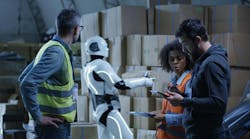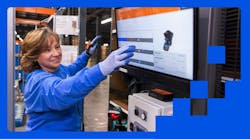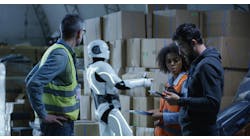Warehouses across the country are facing a potentially crippling labor shortage, driven by a convergence of conflicting factors. E-commerce orders continue to surge, as customers show a growing preference for ordering online—while expecting fast, accurate deliveries. Meanwhile, an already insufficient warehouse workforce, which was further depleted by the pandemic and the “Great Resignation,” has failed to recover, as older workers retire and younger workers eschew warehouse work. As a result, supply chains are being severely strained.
To solve the problem, executives are looking to automation in warehousing, which can provide significant improvements in efficiency when properly applied. But are they focusing on the right types of technology?
Companies need to be wary of buying into hype about the capabilities of humanoid robots, which get a lot of attention these days for their perceived potential to replace workers. The fact is that robots alone will not solve the labor crisis anytime soon. Robotics certainly can help optimize warehouse operations, but only when they are used to complement, not replace, human workers.
Humanoid Robots and ROI Don't Mix
While the long-term promise of humanoid robots able to do the same work as humans is enticing, there are significant drawbacks. Humans are extremely complex, and building humanoid robots that have even a small portion of human capabilities is still aspirational. They are expensive, break constantly, are difficult to repair and maintain, and are severely limited in the tasks they are able to perform. But more importantly, humans in warehouses generally use other machines to do their work.
For example, humans use forklifts and conveyors to move things, fixed robot arms for picking, welding and assembly, and more. Obviously, it wouldn't make sense to build a humanoid to drive a forklift when you can just automate the forklift, for example. There may be some tasks where a humanoid robot could be the most efficient solution, but those have yet to be found. Companies looking to save costs while increasing productivity will find little ROI by turning to humanoid robots.
A Better Way: Man and Machine Working Together
When implementing automation and robotics, it’s important to remember that humans and machines should not be at odds. The goal is to automate workflows in a way that puts humans first, making their jobs easier and more efficient so they can then focus on higher-value tasks.
A good example of this approach is the effort by transport and logistics provider GEODIS to rethink case-picking workflows using pallet jack autonomous mobile robots (AMRs). Rather than having a worker operate a pallet jack manually, driving it and getting on and off to fill an order, GEODIS leveraged AMRs to navigate pick paths while employees loaded goods onto the robots.
Orchestration software manages the system and is integrated with the site’s warehouse management system to optimize order management across the site. The result? A more-than 1.7x throughput gain and a 42% reduction in labor hours compared with manual operations.
Case-picking workflows are an area ripe for improvements. Seventy-eight percent of medium to large material handling operations run those workflows, according to a warehouse automation statistics survey, and they have proved to be among the most difficult jobs to staff with skilled labor.
Focus on Workflows, Not Robots
Organizations that are just getting started with introducing robotics can be overwhelmed with the potential options. After all, no single robot will be able to do every task within the warehouse. A typical facility will require many different types, from AMRs and automated guided vehicles (AGVs) to palletizers, automated storage and retrieval systems (AS/RS), to sorting robots, packing robots and more.
Warehouse operators can benefit by starting small, finding initial success, and then scaling up their use of robotics. And it’s important to focus on the workflow being addressed rather than any particular type of robot. Over the course of a year, you can follow a five-step process:
Month 1: Assess. Start by identifying and prioritizing the workflows to focus on. Using real-time location services (RTLS), you can gather data on all robots, workers, assets, pallets and manual equipment, including resource usage, distances traveled, high-traffic routes, travel time vs. idle time, and other factors. It’s a low-cost way to identify pain points and areas in need of improvement.
Month 3: Plan. By simulating feasible solutions, you can determine ROI at scale, align your plans and define the criteria for measuring success across stakeholders. The solution design can be completed at this stage.
Month 6: Deploy. Start with a small project that is likely to succeed. Select a facility that has bought into automation and deploy a limited-scale demonstration that will meet key performance indicators (KPIs) while familiarizing users with the automated system.
Month 9: Learn. Ramp up the automated solution to full production, integrating it fully in your facility. Customer success will generate further support for management to move forward with ongoing analytics to identify further possible improvements, as well as staff training and adoption of additional automated solutions.
Month 12: Scale. With a proven process and measurable results in hand, you can repeat the original solution at multiple sites, while expanding automation to new workflows at the original test site.
A More Automated and Collaborative Future
Automated warehouses can significantly help organizations overcome their labor shortage by improving efficiencies and optimizing workflows. In fact, automation is essential to being able to compete and succeed in today’s high-speed environment. But don’t buy into the growing misconception in the industry that humanoid robots will replace human workers. Even if robotic systems were currently capable, the costs would outstrip any hope of ROI.
Robotic systems work best when they help humans do their jobs better, more easily and more efficiently. The best approach is to put humans first, start small and focus on what robotics and automation can actually do to improve performance.
Daniel Theobald is founder and chairman of Vecna Robotics, a provider of flexible material handling automation solutions.




